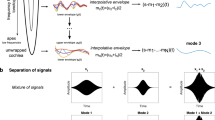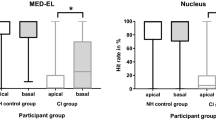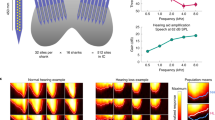Abstract
IF it is true that persons totally deaf in the range of normally audible sounds (30–16,000 c.p.s.) can perceive sound by bone-conduction in the range 16,000–100,000 c.p.s., this is a fact of great importance both for the theory of hearing and for the design and construction of hearing-aids, particularly if perception is associated with any useful degree of frequency discrimination above 16 kc./s.
This is a preview of subscription content, access via your institution
Access options
Subscribe to this journal
Receive 51 print issues and online access
$199.00 per year
only $3.90 per issue
Buy this article
- Purchase on Springer Link
- Instant access to full article PDF
Prices may be subject to local taxes which are calculated during checkout
Similar content being viewed by others
Author information
Authors and Affiliations
Rights and permissions
About this article
Cite this article
PUMPHREY, R. Upper Limit of Frequency for Human Hearing. Nature 167, 438–439 (1951). https://doi.org/10.1038/167438d0
Issue Date:
DOI: https://doi.org/10.1038/167438d0
Comments
By submitting a comment you agree to abide by our Terms and Community Guidelines. If you find something abusive or that does not comply with our terms or guidelines please flag it as inappropriate.



